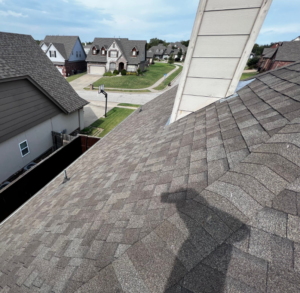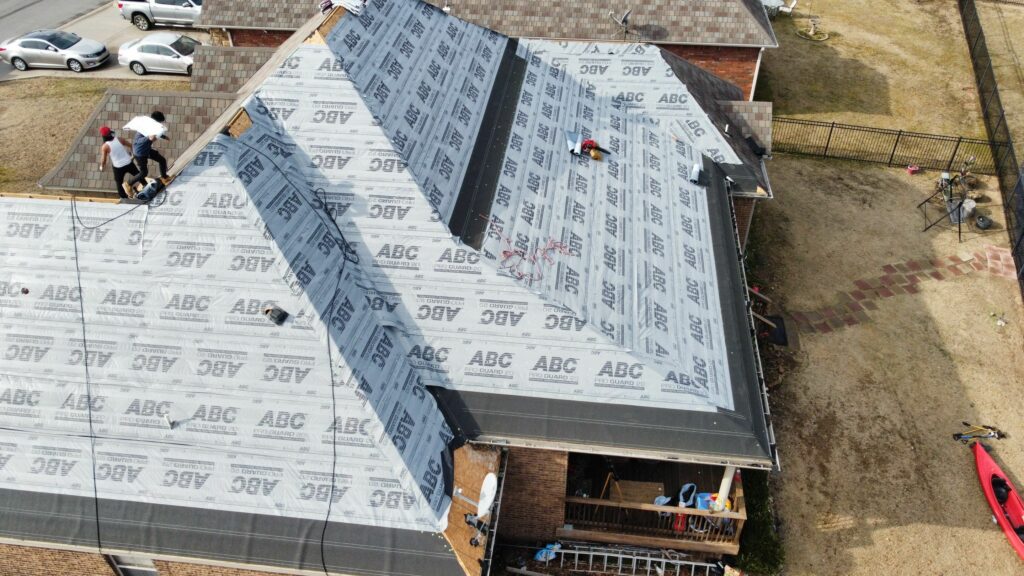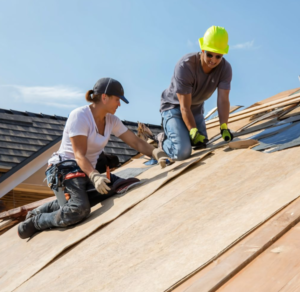
Can You Put New Roof Shingles On Top Of The Old Ones?
Installing new shingles over an existing asphalt shingle roof can be cost-effective, providing immediate installation and extra protection; however, it can hinder proper roof inspection and lead to long-term structural integrity and weight concerns. Understanding the benefits and drawbacks, as well as the importance of proper underlayment and reinforcement, is crucial for making an informed decision about re-roofing. Vent pipes should be covered to prevent leaks and maintain the integrity of the roof. Further insight into assessing the existing roof condition and exploring detailed practices for installation can help ensure the longevity and safety of your roof.
Key Points In This Article
- Installation over existing shingles is possible but may compromise roof integrity.
- Proper assessment of existing roof condition is crucial before re-roofing.
- Consider structural capacity to support additional weight from new shingles.
- Follow manufacturer guidelines for proper installation practices.
- Potential risks include masking underlying issues and voiding warranties.
Pros Of Installing New Shingles Over Existing
 One of the primary advantages of installing new shingles over existing ones is the cost savings that can be achieved, typically averaging around 15%. This cost-saving benefit can be quite significant for homeowners looking to renovate their roofs without breaking the bank. By opting to shingle over existing shingles, individuals can avoid the expenses associated with tear-off, such as labor costs and disposal fees, ultimately resulting in substantial savings.
One of the primary advantages of installing new shingles over existing ones is the cost savings that can be achieved, typically averaging around 15%. This cost-saving benefit can be quite significant for homeowners looking to renovate their roofs without breaking the bank. By opting to shingle over existing shingles, individuals can avoid the expenses associated with tear-off, such as labor costs and disposal fees, ultimately resulting in substantial savings.
Aside from the financial aspect, avoiding tear-off also translates to saving time and immediate installation of the new shingles. This process eliminates the need to strip off the old shingles, which can be labor-intensive and time-consuming to replace a roof. as well as potentially reducing hail damage repair costs. Additionally, shingling over existing shingles provides an extra layer of protection for the roof, enhancing its durability and potentially extending its lifespan.
Furthermore, by shingling over existing asphalt shingles, homeowners can prevent weather interference during the roofing process. This means that inclement weather conditions are less likely to impact the installation timeline, ensuring a smoother and more efficient roof renovation project. Overall, the advantages of installing new shingles over existing ones include cost savings, time and money savings, extra protection, and prevention of weather-related disruptions.
Cons Of Installing New Shingles Over Existing
While the cost-saving benefits of installing new shingles over existing ones are appealing, it is important to consider the drawbacks associated with this approach. By opting for this method, several issues may arise that could potentially lead to more significant problems in the future. Here are some key cons to keep in mind:
| Cons of Installing New Shingles Over Existing |
|---|
| Hinder Proper Roof Inspection |
| Compromise Installation |
| More Expensive in the Long Run |
| Temporary Fix |
| Avoid Thorough Inspection |
Installing new shingles over existing ones can hinder proper roof inspection by concealing underlying issues that may be present. The uneven surfaces created by old shingles can compromise the installation of the new ones, potentially leading to a decrease in their longevity. While it may seem like a cost-effective solution initially, it can turn out to be more expensive in the long run as issues with the old shingles may reduce the lifespan of the new ones. Putting new shingles over old ones may act as a temporary fix rather than a permanent solution to roofing problems, ultimately impacting the long-term roof integrity. To avoid these pitfalls, it is recommended to opt for a thorough inspection and proper installation to ensure the longevity and structural integrity of your roof. Consider calling Luck Roofing for a free inspection of your roof , we are the top roofing contractor in Arkansas.
Structural Integrity Concerns
 A critical consideration when contemplating the installation of new shingles over an existing roof is the potential impact on the structural integrity of the roofing system, particularly regarding how much hail damage may already be present. This process poses significant structural concerns that must be carefully evaluated to prevent damage risks and ensure the long-term stability of the roof.
A critical consideration when contemplating the installation of new shingles over an existing roof is the potential impact on the structural integrity of the roofing system, particularly regarding how much hail damage may already be present. This process poses significant structural concerns that must be carefully evaluated to prevent damage risks and ensure the long-term stability of the roof.
Key points to consider include:
- Weight Load: Adding a new layer of shingles over an existing asphalt shingle roof can double the weight on the structure, potentially exceeding the roof’s intended load-bearing capacity.
- Wear and Tear: The increased weight from the additional layer of shingles can accelerate wear and tear on the roof, leading to premature deterioration and the need for costly repairs.
- Structural Capacity: Roofing structures may not be designed to support the load of two layers of shingles, raising concerns about the overall structural capacity of the roof.
- Re-Roofing Assessment: Before proceeding with re-roofing, it is essential to assess the existing roof’s condition and structural capacity to identify any potential risks of damage and ensure that the roof can safely support the additional weight of a new layer of shingles.
Weight Considerations
Consideration of the weight implications is paramount when contemplating the installation of new shingles over an existing roof to ensure the structural integrity of the roofing system is not compromised. Adding a second layer of shingles significantly increases the weight on the roof, potentially placing excessive strain on the roof structure. Roofs are designed with specific weight limits that should not be exceeded to prevent potential issues such as roof collapse, especially in regions prone to heavy snowfall where the risk of problems due to increased weight is higher. It is crucial to assess whether your roof can support the additional weight of a second layer of shingles before proceeding with the installation.
| Weight Considerations | Implications |
|---|---|
| Existing Shingles | Adds initial weight |
| Second Layer of Shingles | Increases weight |
| Excessive Weight | Strains roof structure |
Proper evaluation of the roof’s condition and weight-bearing capacity is essential to avoid potential structural problems that may arise from exceeding weight limits. If you’re dealing with a leaking shingle, knowing how to repair a leaking shingle promptly can prevent further damage to your roof and interior spaces. Prioritizing the long-term health and safety of your roof by staying within recommended weight limits can help prevent costly repairs or, in extreme cases, a roof collapse due to the added weight of multiple layers of shingles.
Importance Of Proper Underlayment
 Proper underlayment serves as a critical barrier against water infiltration beneath shingles, safeguarding the roof deck from moisture-related deterioration. Adequate underlayment is essential for maintaining the roof’s integrity and ensuring long-term protection.
Proper underlayment serves as a critical barrier against water infiltration beneath shingles, safeguarding the roof deck from moisture-related deterioration. Adequate underlayment is essential for maintaining the roof’s integrity and ensuring long-term protection.
Here are key points highlighting the importance of proper underlayment:
- Prevention of Water Seepage: Underlayment acts as a waterproofing layer that prevents water from penetrating through the shingles into the roof structure. This is crucial in safeguarding the roof deck from moisture damage, which can compromise the structural integrity of the roof over time.
- Moisture Protection: Proper underlayment provides an additional layer of defense against moisture, condensation, and leaks. It helps in maintaining a dry and stable roof environment, reducing the risk of mold, rot, and other issues caused by water intrusion.
- Ensuring Roof Integrity: Without adequate underlayment, the roof’s structural integrity can be significantly compromised. Proper underlayment installation is necessary to protect the roof from potential damage caused by water, wind-driven rain, or snow infiltration.
- Facilitating Proper Inspection: Removing the old roof during a replacement allows for a thorough inspection of the roof deck and the underlying structures. This inspection is crucial for identifying any issues, such as rot or damage, and ensures that the new underlayment is installed correctly to protect the roof effectively.
Impact On Long-Term Roof Protection
The longevity of a roof’s protection can be significantly compromised when new shingles are installed over existing ones, potentially leading to various long-term issues, including how to repair a roof leak. One of the key concerns is the hindrance in establishing a proper water and ice leak barrier, which can result in undetected leaks causing damage to the roofing structure. The presence of old shingles underneath the new layer can mask underlying roof issues, delaying essential repairs and escalating long-term costs. Additionally, the added weight strain from the second layer of shingles can surpass the roof’s capacity, posing a risk of structural damage and even collapse.
To further understand the impact of installing new shingles over existing ones, consider the following table:
| Concerns | Impact |
|---|---|
| Water Barrier | Hindered installation leading to undetected leaks |
| Structural Damage | Risk due to weight strain exceeding the roof’s capacity |
| Manufacturer Warranties | Potential voiding, affecting protection and coverage for the roof |
| Building Regulations | Prohibitions in some areas, non-compliance may result in penalties and safety hazards |
It is crucial to adhere to building regulations regarding roofing installations to ensure the safety and longevity of the structure. Furthermore, manufacturers’ warranties may be voided if proper installation procedures are not followed, emphasizing the significance of addressing these long-term concerns when considering new shingle installation over an existing roof.
Cost-Effectiveness Of Installation
How does installing new shingles over existing asphalt shingles impact the cost-effectiveness of roofing projects? When considering the cost-effectiveness of this method, several factors come into play:
- Labor Savings: Installing new shingles over existing ones can save approximately 15% on average in labor costs. This is because there is no need for the time-consuming process of tearing off the old shingles, reducing the overall labor hours required for the project.
- Disposal Savings: By shingling over the existing roof, you can also save on disposal costs. Eliminating the need to remove and dispose of the old shingles can contribute to significant cost savings for the project.
- Project Efficiency: This method allows for immediate installation of the new shingles, bypassing the time-consuming tear-off process. As a result, the overall project time is reduced, leading to increased efficiency and potentially lower overall costs.
- Additional Protection and Roof Lifespan: Installing new shingles over existing ones provides an additional layer of protection for the roof. This added layer can potentially extend the lifespan of the roof by offering extra defense against the elements.
While this method offers cost-saving benefits, it is essential to consider potential risks such as skipping roof deck and underlayment inspections, which could impact the long-term integrity of the roof, especially in the context of roof replacement.
Reinforcement From Old Shingles
Utilizing the existing shingles as reinforcement can help maintain the structural strength of the roof, offering a cost-effective solution.
Proper installation practices such as ensuring the new shingles are securely fastened over the old ones are essential to maximize the benefits of this method.
Structural Strength Retained
When installing new shingles over an existing asphalt shingle roof, the structural strength can be significantly enhanced by utilizing the reinforcement provided by the old shingles. This method offers several benefits:
- The old shingles act as an added layer of protection for the roof.
- Reinforcing the roof’s integrity and durability.
- The additional layer of shingles enhances the overall strength of the roof structure.
- By keeping the old shingles, the new shingles benefit from the underlying support and stability, leading to a more robust roofing system.
Cost-Effective Option
The cost-effective option of utilizing the reinforcement provided by old shingles when installing new shingles over an existing asphalt shingle roof offers both financial savings and enhanced structural strength. By opting for this method, homeowners can save money by avoiding the tear-off process of the old shingles while benefiting from an additional layer of protection for their roof. Proper installation over existing shingles can also help extend the lifespan of the roof, making it a practical choice for those looking to enhance their roof’s durability without breaking the bank.
| Benefits | Description |
|---|---|
| Cost-effective | Saves money by avoiding tear-off process |
| Enhanced protection | Adds an extra layer of defense |
| Extended roof lifespan | Proper installation can prolong roof life |
Proper Installation Practices
 To ensure the proper reinforcement from old shingles during the installation of new shingles over an existing asphalt shingle roof, meticulous attention to detail and adherence to industry best practices are paramount, especially considering factors like roof leak repair cost. Proper installation practices play a crucial role in maximizing the benefits of this method, enhancing the roof’s durability, longevity, and overall performance.
To ensure the proper reinforcement from old shingles during the installation of new shingles over an existing asphalt shingle roof, meticulous attention to detail and adherence to industry best practices are paramount, especially considering factors like roof leak repair cost. Proper installation practices play a crucial role in maximizing the benefits of this method, enhancing the roof’s durability, longevity, and overall performance.
Here are key considerations for roofing experts to follow:
- Evaluate the condition of existing roofing materials to ensure they can support the additional weight.
- Securely fasten the new shingles to the old shingle layer to maintain the roof structure’s integrity.
- Enhance impact resistance by leveraging the presence of the old shingles.
- Follow manufacturer guidelines for proper installation techniques to optimize the system’s effectiveness and longevity.
Assessing Existing Roof Condition
Assessing the condition of the existing roof involves a thorough examination for signs of damage, such as curling, cracking, or missing shingles. It is essential to inspect the roof deck for any indications of rot or water damage before considering the installation of new shingles over the existing asphalt shingle roof.
Areas with algae or moss growth on the old shingles should be identified and addressed to ensure a suitable surface for the new shingles. Proper ventilation is crucial to prevent moisture buildup that can lead to premature deterioration of the shingles. Additionally, checking if the roof structure can support the additional weight of a second layer of shingles is necessary to avoid structural issues in the future.
Before proceeding with adding new shingles, evaluating the overall integrity of the existing asphalt shingle roof is paramount. Any underlying issues or weaknesses in the current roof should be addressed to ensure the longevity and effectiveness of the new shingles. By conducting a comprehensive assessment of the existing roof condition, including the roof deck, signs of damage, ventilation, and structural capacity, homeowners can reach well-considered conclusions regarding the installation of new shingles over an existing asphalt shingle roof.
To Conclude
To sum up, installing new shingles over an existing asphalt shingle roof can have both benefits and drawbacks.
It is important to consider factors such as structural integrity, weight considerations, proper underlayment, long-term roof protection, cost-effectiveness, and reinforcement from old shingles.
Assessing the existing roof condition is crucial in determining whether this method is suitable for your roof.
Michael Overzat
Michael Overzat resides in Fort Smith, Arkansas with his wife and three kids. He enjoys to hike, skateboard, write, and get involved in charity organizations. He was originally born in Maryland. He has worked within the roofing industry for 5 years and is very active within the industry by attending conferences, masterminds, etc. His vision is to create a multi-state organization that has a customer centric model. He's worked for some of the biggest names in the industry and hopes to create a more people focused model for the roof replacement process.
